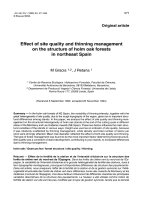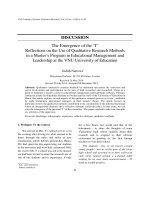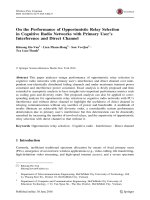Perception on the quality of vocational education training in VietNam Basis to improve VietNam education training quality
Bạn đang xem bản rút gọn của tài liệu. Xem và tải ngay bản đầy đủ của tài liệu tại đây (1.11 MB, 166 trang )
PERCEPTION ON THE QUALITY OF VOCATIONAL EDUCATION
TRAINING IN VIETNAM: BASIS TO IMPROVE VIETNAM
EDUCATION TRAINING QUALITY
___________________________
A DISSERTATION
Presented to the Faculty of the Graduate School
Southern Luzon State University, Lucban, Quezon, Philippines
in Collaboration with
Thai Nguyen University, Socialist Republic of Vietnam
___________________________
In Partial Fulfillment
of the Requirements for the Degree
Doctor of Business Administration
___________________________
By
NGUYEN CHI TRUONG (BUSH)
December 2013
i
APPROVAL SHEET
The Dissertation of
NGUYEN CHI TRUONG
entitled
PERCEPTION ON THE QUALITY OF VOCATIONAL EDUCATION
TRAINING IN VIETNAM: BASIS TO IMPROVE VIETNAM
EDUCATION TRAINING QUALITY
Submitted in Partial Fulfilment of the Requirements for the Degree
DOCTOR OF BUSINESS ADMINISTRATION
A program offered by Southern Luzon State University,
Republic of the Philippines in collaboration with
Thai Nguyen University, Socialist Republic of Vietnam
has been approved by Oral Examination Committee
JOANNA PAULA A. ELLAGA, DBA
Expert
NELLY I. MENDOZA, DBA
Expert
EDWIN P. BERNAL, DBA
Expert
ALICE T. VALERIO, PhD
External Panel
CECILIA N. GASCON, PhD
Chairman
Endorsed by:
Recommended by:
CONRADO L. ABRAHAM, PhD
Adviser
APOLONIA A. ESPINOSA, PhD
Dean
Accepted in Partial Fulfilment of the Requirements for the Degree
Doctor of Business Administration
_____________________
Date
WALBERTO A. MACARAAN, EdD
Vice President for Academic Affairs
ii
CERTIFICATE OF ORIGINALITY
iii
ACKNOWLEDGMENT
Grateful acknowledgment is hereby given to the following individuals who in
one way or another, made this DBA study more bearable and meaningful in the midst
of academic pressures; and because of their presence and inspiring assistance, the
researcher was able to transcend human weaknesses into strength and was able to
respond to the challenges of achieving creativity and success:
Dr. Conrado L. Abraham (SLSU), his first adviser, who gave him the strength
and the encouragement to believe in his capacities, and taught him not to be afraid
and to keep holding on and be steadfast in achieving his vision/mission. In addition,
he patiently “listened” to him in his “down” moments and guided him with his wisdom
in the completion of this dissertation;
Dr. Cecilia N. Gascon (SLSU), Dr. Tran Chi Thien (TNU), Dr. Walberto A.
Macaraan, Dr. Joanna Paula A. Ellaga, Dr. Nelly I. Mendoza and Dr. Eduardo T.
Bagtang, the panel of examiners, for their invaluable and constructive comments in
improving the manuscript;
Prof. Dr. Duong Duc Lan, Director General, General Directorate of Vocational
Training, his external panelist and seasoned expert and also a high ranking policy
leader in Vietnam Vocational Technical Education Training system as the Director
General, General Directorate of Vocational Training, who shared his precious time in
giving him commendable advice which are valuable in developing the dissertation
framework;
All his mentors/professors in the DBA class who provided him with leadership
and managerial skills combined with the “IQ and EQ” formations so that he can be
one of those humble yet synergized souls who believe that the community and
people-centered development is achievable in our midst;
iv
Colleagues from the General Directorate of Vocational Training who helped
him in the collection of data and information;
The Staff of the International Training Center (ITC), Thai Nguyen University
and the staff of the University of Labor and Social Affairs, for all the services they
have extended to him especially with regards to facilitating his schedules, providing
him the convenience and good environment for studying;
His classmates for the stimulating and effective learning discussions on case
studies and adding more value to his life during his study in DBA class;
Special mention is extended to Do Thi Hoa, Hoang Van Hung, Le Ngoc
Quang, who never failed to support him in times of difficulty;
Nguyen Phuc Huong and Tran Xuan Ngoc (Ronaldo), Nguyen Xuan Phuc
(Clinton), his roommates during his study time at Thai Nguyen University for being
good friends, sharing with him joys and sorrows, happiness and tiredness during the
time of studying in Hanoi and Thai Nguyen City;
His mother, sisters and friends and collaborative partners, who had always
been with him and never ceased to support him through their patience;
Most especially, to his wife, Tong Thi Thu Hang, for her love, patience, and
belief in his abilities; for her sacrifices and understanding of leaving their home every
Saturday, Sunday and often coming home late after official working time to attend the
DBA class, especially during the conduct of his dissertation, and most importantly for
taking care of their home and their family;
And to his daughter Nguyen Huong Giang and his son Nguyen Chi Truong
Son, for giving him the reason to finish this dissertation and for their smiles that bring
him energy and inspiration.
Nguyen Chi Truong
v
DEDICATION
To my ever loving mother, all my sisters, my wife, my children who gave me
the energy and strength to withstand the tests of the ‘unknown’
and the entirely new and unique experiences during my
study and in completing my dissertation, this
piece of work is lovingly dedicated.
NCT
vi
TABLE OF CONTENTS
PAGE
TITLE PAGE ………………………………………………………………..
i
APPROVAL SHEET ……………………………………………………….
ii
CERTIFICATE OF ORIGINALITY ………………………………………..
iii
ACKNOWLEDGEMENT …………………………………………………..
iv
DEDICATION ………………………………………………………………
vi
TABLE OF CONTENTS …………………………………………………..
vii
LIST OF TABLES ………………………………………………………….
ix
LIST OF FIGURES ………………………………………………………...
xii
ABBREVIATIONS ………………………………………………………….
xiii
LIST OF APPENDICES …………………………………………………...
xiv
ABSTRACT …………………………………………………………………
xvi
CHAPTER
I
II
III
INTRODUCTION ……………………………………………
1
Background of the Study …………………………………..
3
Statement of the Problem ………………………………….
6
Objectives of the Study …………………………………….
7
Hypothesis of the Study ……………………………………
8
Significance of the Study …………………………………..
9
Scope and Limitations of the Study ………………………
10
Definition of Terms ………………………………………….
11
REVIEW OF LITERATURE ……………………………….
13
Theoretical Framework ………………………………….…
53
Conceptual Framework ………………………………….…
54
METHODOLOGY …………………………………………..
55
Locale of the Study …………………………………………
55
Research Design ……………………………………………
55
Population and Sampling …………………………………..
56
Research Instrument ……………………………………….
56
vii
Data Gathering Procedure …………………………………
58
Statistical Treatment ………………………........…….……
59
IV
RESULTS AND DISCUSSIONS ………………………….
61
V
SUMMARY OF FINDINGS, CONCLUSIONS AND
RECOMMENDATIONS ……………………………………
111
Summary of Findings ………………………………………
111
Conclusions …………………………………………………
114
Recommendations …………………………………………
114
BIBLIOGRAPHY ….…………………...…………………………………..
124
APPENDICES ……………………………………………………………...
127
CURRICULUM VITAE …………………………………………………….
147
viii
LIST OF TABLES
TABLE
1
PAGE
Number of Professional Technical Education and Training
Institutions, Teachers and Students (2009~10)
35
2
2013 Status on Approved NOSS in Vietnam
47
3
Vietnamese Legislation & Regulation on Certification
System
52
4
Questionnaires’ Point Range
57
5
Demographic Information of the Respondents
62
6
Reliability Statistics on Individual Characteristics
64
7
Mean Distribution of Respondents Perception in Terms of
Individual Characteristics
65
8
Reliability Statistics on Qualification of Lectures
66
9
Item – Total Statistics of Qualification of Lecturers’
Variable
66
Mean Distribution of Respondents Perception in Terms of
Qualifications of Lecturers
67
11
Reliability Statistics on Physical Facilities
68
12
Item – Total Statistics of the Physical Facilities
68
13
Mean Distribution of Respondents’ Perception in Terms of
Physical Facilities
69
14
Reliability Statistics on Management Capacity
70
15
Item – Total Statistics of Management Capacity’s Variable
70
16
Mean Distribution of Respondents’ Perception in terms of
Management Capacity
71
17
Reliability Statistics on Job Opportunities
72
18
Item – Total Statistics of Job Opportunities
72
19
Mean Distribution of Respondents’ Perception in terms of
Job Opportunities
73
10
ix
TABLE
PAGE
20
Reliability Statistics on Labor Market Information
74
21
Item – Total Statistics of Information on Labor Market’s
Variable
74
Mean Distribution of Respondents’ Perception in terms of
Information on Labor Market
75
23
Reliability Statistics on Support Policies
76
24
Item – Total Statistics of Support Policies
76
25
Mean Distribution of Respondents’ Perception in terms of
Support Policies
77
26
Average Evaluation
78
27
Descriptive Statistics
79
28
Model Summary
80
29
ANOVA
81
30
Result of Linear Regression Analysis
81
31
Test of Homogeneity of Age Variance
83
32
Comparison between the Respondents’ Perception in
Terms of Age
84
33
Test of Homogeneity of Gender Variance
85
34
Comparison between the Respondents’ Perception in
Terms of Gender
86
35
Test of Homogeneity of Marital Status Variance
87
36
Comparison between the Respondents’ Perception in
terms of Marital Status
88
37
Test of Homogeneity of Income Variance
89
38
Comparison between the Respondents’ Perception in
Terms of Income
90
22
x
TABLE
PAGE
39
Test of Homogeneity of Educational Level Variance
91
40
Comparison between the Respondents’ Perception in
terms of Educational Level
92
Comparison between the Respondents’ Perception when
they are Grouped following Related Profile
93
Number of Meister Schools and their Students in Korea
100
41
42
xi
LIST OF FIGURES
FIGURE
PAGE
1
Types of VET Benefits
16
2
National Education Training System and Relationship
between General Education and VET in Viet Nam
36
3
Problem Tree of VET in Viet Nam
38
4
NOSS is a Key Factor for Development of VET
43
5
Importance of NOSS and Relations among NOSS,
Certification and VET
44
6
Theoretical Framework
53
7
Conceptual Framework
54
8
Objectives Tree to Solve Current Problems for Improving
Quality of the VET
105
xii
ABBREVIATIONS
ADB
Asia Development Bank
ANOVA
Analysis of Variance
AQTF
Australian Quality Training Framework
BOG
Board of Governors
CPSISC
Construction and Property Services Industry Skills Council
CVET
Continuous Education Training
DEEWR
Department of Education, Employment and Workforce Relations
DETB
District Education and Technical Board
DSD
Development Skills Department
GDP
Gross Domestic Product
GDVT
General Directorate of Vocational Training
IAC
Industry Advisory Council
ILO
International Labor Organization
ISC
Industry Skills Council
ITI
Industrial Training Institutes
IVET
Initial Educational Training
KCSE
Kenya Certificate of Secondary Education
KNEC
Kenya National Examination Council
KOICA
Korean International Cooperation Agency
KRIVET
Korea Institute of Vocational Education Training
MOET
Ministry of Education and Training
MOLISA
Ministry of Labor, Invalids and Social Affairs
MPE
Master Plan on Education
NOSAC
National Occupational Skill Assessment Center
NOSS
National Occupational Skills Standard
xiii
NOSTC
National Occupational Skills Testing Centers
NQF
National Qualification Framework
NQF
National Qualification Framework
NSDC
National Skill Development Corporation
NSSC
National Skills Standards Council
NSTCS
National Skills Testing and Certification System
NSTMA
National Skills Testing Management Agency
NTIS
National Training Information Service
OLS
Ordinary Least Squares
OSD
Occupational Skills Department
RTO
Registered Training Organization
SCOTESE
Standing Council on Tertiary Education Skills and Employment
SDF
Skill Development Fund
SPSS
Statistical Package for Social Sciences
SSC
Sector Skills Council
STC
Skills Testing Center
SWOT
Strengths Weakness Opportunities Threats
TAFE
Technical and Further Education
TEP
Technical Education Program
TESDA
Technical Education and Skills Development Authority
TIQET
Totally Integrated Quality Education and Training
UK
United Kingdom;
UNEVOC:
UNESCO – Vocational Education
(International Centre for Technical and Vocational Education and Training)
VET
Vocational Education and Training
VIF
Variance Inflation Factor
xiv
LIST OF APPENDICES
APPENDIX
A
B
PAGE
Regulation Principles, Procedures of Developing and
Issuing National Skills Standards
128
Questionnaire
144
`
xv
ABSTRACT
Title of Research
: PERCEPTION ON THE QUALITY OF
VOCATIONAL EDUCATION TRAINING IN
VIETNAM: BASIS TO IMPROVE VIETNAM
EDUCATION TRAINING QUALITY
Researcher
: NGUYEN CHI TRUONG (BUSH)
Degree Conferred
: DOCTOR OF BUSINESS ADMINISTRATION
Name and Address
of Institution
: Southern Luzon State University Lucban, Quezon,
Philippines and Thai Nguyen University, Socialist
Republic of Vietnam
Adviser
: Dr. Conrado L. Abraham
Year Written
: 2013
______________________________________________________________
Vocational education and training play a key role in raising skill levels
and improving the society’s productivity. The demand for skilled workers has
increased job specifications in the use of technology. Vocational Education
Training helps people in improving their performances in their jobs as they
acquire a great learning experience. Working professionals get a chance to
hone their skills while increasing their income. On May 2012, Vietnam
government has approved and issued two important national strategies that
have the general objective to develop an education vocational training system
to support the development of socio-economy for our country’s mission “will
basically become a developed country by 2020”. These policies assert that
vocational education training is essential for Vietnam’s development. In this
context, the dissertation proposed a system of a set of criteria to evaluate the
quality of Vocational Education Training and analyze the status of VET in
Vietnam, especially its weak points. In addition, the study introduces modern
models and value experiences from developed countries in improving
xvi
Vocational Education Training. Further, the dissertation used multivariate
regression equation to evaluate fully factors affecting the quality of Vocational
Education Training in Vietnam. Based on these analyses, the dissertation
proposed highly value recommendations to improve Vocational Education
Training in meeting the demands of industries and government’s vision.
Keywords: Vocational Education Training, Labor Quality, National
Qualification Framework, National Occupational Skills Standard, Industry
Skills Council
xvii
Chapter I
INTRODUCTION
Since “innovation” policy started in 1986, Vietnam Vocational
Educational Training (VET) has concentrated for development in 1998, when
the Government established the General Directorate of vocational training that
belongs to the Ministry of Labor, Wars invalid and Social affairs (MOLISA). At
this particular time, Vietnam has been implementing “innovation” policy for
over 10 years and has gained success in terms of socio-economic
development. Foreign investors have directly increased investment, industries
contribute higher rate to the GDP, economic structure has strongly shifted
from agriculture to industry and also labor force has moved from agriculture
sector to industry sector.
Since the start of its establishment, the General Directorate of
vocational training has developed policies for vocational training development
to meet the needs of industries in terms of skilled workforce, however, the
quality and quantity as well as productivity were low. Nonetheless, the mission
of vocational education training is to produce skilled labor force for country’s
vision to become a modern and developed country by 2020.
Considering the above mission, from 1998 to present, the General
Directorate of vocational training has been developing many positive policies
to develop vocational education training system. According to GDVT, the
number of vocational training schools has been increasing each year. In 2008,
there were 129 vocational training schools, but in 2012, there were only a total
of 455 vocational training schools, in which there are 155 vocational training
2
colleges, 305 secondary vocational training schools, 900 vocational training
centers and about 1,000 related vocational training institutions nationwide.
With regards to the entries of vocational training system, according to GDVT,
it has been increasing in quantity’s entries: from 526,600 in 1998 to 1,538,000
in 2008 and to 1,790,000 in 2012, thus, giving remarkable contributions for the
country’s industrialization and modernization processes.
In terms of law and policy development, one of its remarkable
achievement is that the Government has issued the law on vocational training
in 2005 for the first time, which formalized VET system with 3 levels training in
3 vocational training institutions/vocational training colleges/ secondary
schools for vocational training and primary vocational training schools. These
three kinds of vocational training institutions system have produced a
considerable number of skilled workforce for labor market and serve the
industry needs, thus, contributing to the socio-economic development in the
past years.
However, the existing VET system still has limitations in terms of
producing skilled labor force to fit the industry needs. According to VCCI’s
survey in 2011, indicator in satisfaction of industries about quality of VET was
only 34% and this is a low indicator. The quality of Vietnam labor force is still
low; it was placed in the 11th position among 12 Asian countries which have
been ranked in 2008. Vietnam’s productivity in comparison with some
countries in 2007 is as follows: lower than Japan 50.4 times; Korea 18.6 times;
Malaysia 7.8 times; Thailand 1.96 times; and Indonesia 1.5 times. In addition,
Vietnam has insufficient skilled labor and low competitiveness (according to
3
the Global Competitiveness Index (GCI) for the 2013-2014 periods, Vietnam
placed on the 70th positions among 148 economies in the world.
The limitation of VET may come from limitations of factors influencing
its quality such as capacity of teachers/instructors, management capacity,
physical facilities, and information on labor market, graduates employability;
support policies; connection with industries, etc
Background of the Study
At present, new technology in almost industries has been changing
very fast. In this process, it is necessary to request for the upgrading of skilled
workforce including existing skill areas and new skill areas that arise to meet
the demands for socio-economic development in the new era.
This will
challenge the Vietnamese Vocational Education Training (VET) on how it can
be flexible in terms of changing the industry needs. In order to solve these
problems, VET should improve and strengthen its training capacity to meet
the requirements of high skilled human resources in the new context. Thus, it
should develop policies, strategies, plans and curricula, training programs that
are scientific and advanced enough, and suitable and fit with existing industry
needs.
In fact, in order to have a flexible VET system, other countries like the
United Kingdom has the Sector Skills Councils (SSCs); and Australia has the
Industry Skills Councils (ISCs). In two these countries, the model of SSC or
ISC could play as a bridge to connect between industry, VET and government.
In Japan and Korea, they developed the testing and certification systems
4
separately from the training side (VET) to supply skilled labor for labor market.
This model also has strong engagement of industry to Vocational Education
Training. In Vietnam, in 2008, Ministry of Labor, Invalids and Social Affairs
(MoLISA) has introduced a new frame work to develop a National
Occupational Skills Standards (NOSS) under Decision No. 09/2008/QĐBLĐTBXH dated 28th March 2008 in regulating the principles and procedures
for development and issuance of NOSS. Under this framework, the ministries
will develop the national occupational skills standards for each occupational
under ministry’s management and collaboration for approval and issuance of
NOSS by MoLISA.
The advantages of the NOSS is it serves as a foundation for: General
Directorate of Vocational training (GDVT) as an agency that is authorized by
MoLISA to manage the development of NOSS to manage the national skills
testing and certification systems and help MoLISA to issue other related
policies in terms of skilled workforce development; for VET institutes to
develop the curricular and training program; for employers to develop the
employee recruitment, wage payment plans and to identify the training needs
and arrange working position for employees; for the laborers to identify these
skills gaps and improve for themselves to seek for the job. However, NOSS
only has real value as the above mentioned advantages, the procedure and
process to develop NOSS should be strongly engaged by industries. On the
other hand, industries must be involved to identity the skills needed in each
area since these are the requirements for manufacturing and should be
developed through training. Unfortunately, there is a lack of participation of
industries in this process. Therefore, NOSS seems not functional any more as
5
to government expectation and socials needs in terms of human resources
development, especially in training program or curricular development.
Towards 2020, Vietnam’s strategy for socio-economic development
stage 2011-2020 has formulated one of three pillars for socio-economic
development that is “human resource development”. The strategy for human
resource development stage 2011 – 2020 has formulated “development of
regulations, mechanisms, policies to speed up training towards social needs
driven,
engagement
of
enterprise
in
training”
and
“basically
and
comprehensive innovation of education and training to meet the demands for
social development”.
On May, 2012, Vietnam government has approved and issued two
important national strategies: (1) strategy for development of education stage
2011- 2020, and (2) strategy for the development of Vocational Education
Training stage 2011 – 2020. These two strategies have the objectives that
aims to find solutions to “comprehensive and basic innovation of education
and training for social development needs; improve the training quality as
requirements in terms of standardization, modernization, socialization, and
international integration to efficiently serve the development of and defend
motherland” that has been approved by the government as strategy for
human resources development period 2010 – 2020 and contribute to the
country’s mission “to become a developed country by 2020”.
Thus, this
dissertation discussed the “Perception on the Quality of Vocational
Education Training in Vietnam: Basis to Improve Vietnam Education
Training Quality ”
6
Statement of the Problem
International economic integration makes the national economies of the
region and the world increasingly closely linked. Technology changes so fast
and industries of each country have to constantly upgrade new technology for
improving their productivity. Vocational training sector plays an important role
for this process to upgrade the skilled workforce to fit with the industry needs,
which is a key factor for improving country’s competitiveness in the integration
process. One of the requirements for socio-economic development in stage
2012-2020 is to improve the skilled workforce and to meet the industry needs.
In connection with this, the Vietnam Government has approved a strategy for
the development of vocational education training stage 2011–2020 to
innovate basically the comprehensive vocational education training. Therefore,
this paper discussed on policies, models and development of those policies
and models from the perspective of policy makers in order to engage
industries more in VET process in Vietnam. On the other hand, based on the
new strategies for development of educational and vocational trainings just
approved by Government, this paper discussed how to develop a policy and
introduce a model for developing a national occupational skills standards
(NOSS) with the strong participation from industry side and other related sides,
including professional associations, training sides, researchers, policy makers,
employer’s representatives, worker’s representatives etc. The revised NOSS
will be an important factor for training (vocational training institutes) to develop
curriculum, training program (training packages) based on industry needs.
Also, NOSS will be a place for the industry to meet the skills needs of their
manufacturing process and for vocational training sector that can produce
7
skilled workforce. What are the policies and models that can effectively
support Vietnam vocational training in Vietnamese context towards 2020?
Specifically, this study sought to answer the following questions:
1. What is the profile of the respondents in terms of age, gender,
educational level, civil status and income?
2. What is the perception of respondents in terms of individual
characteristics, training quality, physical facilities, management
capacity, job opportunities, information on labor market, support
policies?
3. What are the factors influencing vocational education training?
4. What are the problems of Vocational Education Training of Vietnam
and experiences from developed countries?
Objectives of the Study
The study aimed to evaluate the status of vocational education training
in Viet Nam and determine the factors that influence the quality of vocational
education training.
Specifically, this study aimed:
1. To describe the profile of the respondents in terms of:
1.1 Age
1.2 Gender
1.3 Educational level
8
1.4 Marital status
1.5 Income
2. To compare vocational education training as perceived by training
staff, learners and managers in VET sector in terms of:
2.1 Individual Characteristics
2.2 Training Quality
2.3 Physical Facilities
2.4 Management Capacity
2.5 Job Opportunities
2.6 Information on Labor Market
2.7 Support Policies
3. To compare the quality of VET and determine factors influencing
the quality of vocational education training.
4. To compare the perceived quality of VET when they are grouped in
terms of selected personal characteristics and responses.
Hypotheses of the Study
1. There is a significant difference between perceptions of respondents
and respondent’s profile in terms of age, gender, educational level,
marital status, income.
2. There is no significant difference in the perception of respondents in
terms of individual characteristics, training quality, physical facilities,









